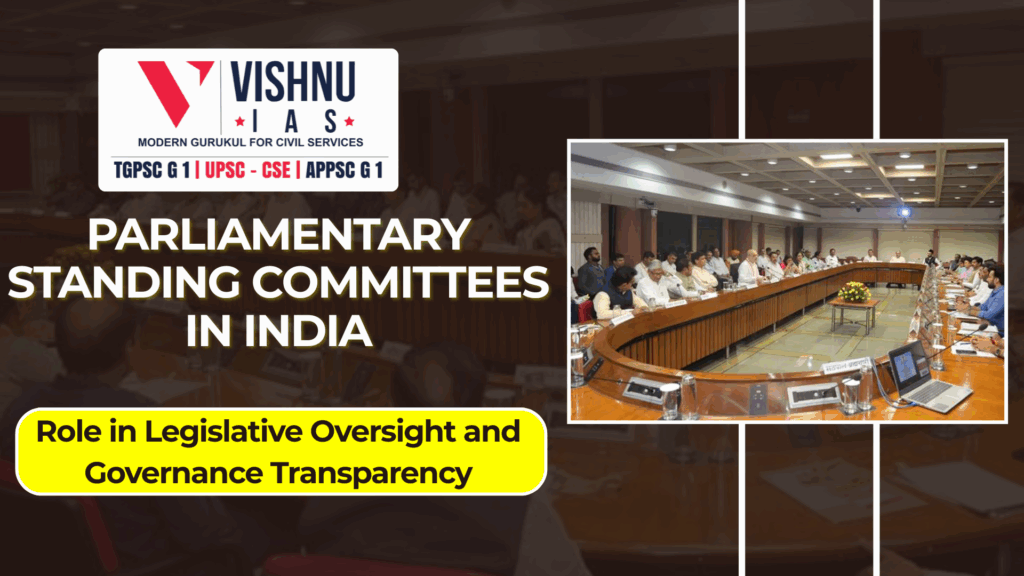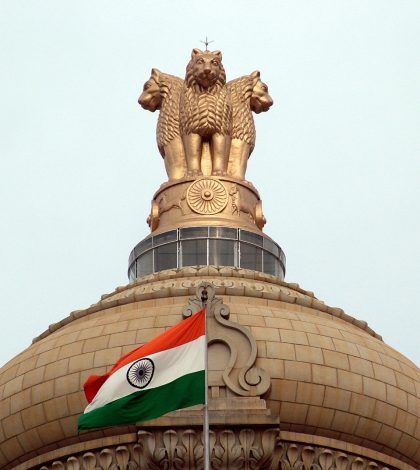Parliamentary Standing Committees in India: Role in Legislative Oversight and Governance Transparency
Introduction
Parliamentary Standing Committees are integral to the Indian legislative framework, serving as specialized bodies that enhance the efficiency, accountability, and transparency of parliamentary proceedings. These committees, comprising Members of Parliament (MPs), are tasked with detailed examination of legislative proposals, budgetary allocations, and policy implementations. Their role becomes particularly significant given the limited time available during parliamentary sessions to scrutinize complex issues thoroughly.
According to data from PRS Legislative Research, during the 17th Lok Sabha (2019-2024), the effectiveness of parliamentary oversight mechanisms like the Question Hour was compromised, functioning for only 60% of its scheduled time in the Lok Sabha and 52% in the Rajya Sabha. This underscores the critical need for robust committee systems to ensure comprehensive legislative scrutiny and executive accountability.
Functions of Parliamentary Standing Committees
1. Legislative Scrutiny
Detailed Examination of Bills: Standing Committees meticulously analyse legislative proposals, allowing for in-depth discussions that are often not feasible in the full House due to time constraints.
Incorporation of Expert Opinions: These committees often seek inputs from experts, stakeholders, and civil society, ensuring that diverse perspectives inform the legislative process.
Bipartisan Deliberation: The committee system facilitates cross-party collaboration, enabling constructive debates and consensus-building on legislative matters.
2. Financial Oversight
Budgetary Analysis: Committees like the Estimates Committee and the Public Accounts Committee (PAC) scrutinize government expenditures, ensuring fiscal responsibility and efficiency.
Audit Examination: The PAC examines reports from the Comptroller and Auditor General (CAG), identifying financial irregularities and recommending corrective measures.
Policy Evaluation: Through financial oversight, committees assess the effectiveness of government schemes and programs, influencing policy adjustments.
3. Policy and Program Evaluation
Monitoring Implementation: Committees track the execution of policies and programs, identifying bottlenecks and suggesting improvements.
Impact Assessment: They evaluate the outcomes of government initiatives, ensuring that objectives are met and resources are utilized effectively.
Feedback Mechanism: Committees serve as a conduit for public and expert feedback, integrating ground-level insights into policy refinement.
4. Ensuring Executive Accountability
Questioning Ministers: Committees have the authority to summon ministers and officials, holding them accountable for their departments’ performance.
Reporting to Parliament: Findings and recommendations are presented to the Parliament, fostering transparency and informed decision-making.
Influencing Governance: Through their oversight functions, committees can prompt administrative reforms and enhance governance standards.
Challenges Faced by Parliamentary Standing Committees
1. Limited Time and Resources
Time Constraints: The increasing volume and complexity of legislation often outpace the time allocated for committee deliberations.
Inadequate Research Support: Committees sometimes lack access to comprehensive research and data, hindering thorough analysis.
Staff Shortages: Limited administrative and technical staff can impede the committees’ ability to function optimally.
2. Implementation of Recommendations
Non-Binding Nature: Committee recommendations are advisory, and the executive is not obligated to implement them, potentially diminishing their impact.
Delayed Responses: Government responses to committee reports can be slow, affecting timely policy corrections.
Lack of Follow-Up: There is often insufficient monitoring of whether accepted recommendations are implemented effectively.
3. Transparency and Public Engagement
Closed Proceedings: Committee meetings are generally not open to the public, limiting transparency.
Limited Public Awareness: The general populace may be unaware of committee functions and findings, reducing public engagement.
Accessibility of Reports: Reports may not be readily accessible or presented in user-friendly formats, hindering public understanding.
4. Political Dynamics
Partisan Influences: Political considerations can sometimes overshadow objective analysis within committees.
Dominance of Ruling Party: The majority party may exert disproportionate influence, affecting the neutrality of committee proceedings.
Attendance Issues: Irregular attendance by members can compromise the effectiveness of committee work.
Case Studies Illustrating Committee Impact
1. Standing Committee on Railways (2015-16)
Dividend Waiver Recommendation: The committee recommended waiving the dividend payment by Indian Railways to the government, amounting to ₹8,722 crore.
Financial Relief: This move provided financial relief to Indian Railways, allowing for increased investment in infrastructure and services.
Policy Shift: The recommendation led to a significant policy change, reflecting the committee’s influence on financial decisions.
2. Standing Committee on Transport, Tourism and Culture (2017)
Motor Vehicles (Amendment) Bill Review: The committee examined the bill, suggesting amendments to enhance road safety and regulatory frameworks.
Stakeholder Engagement: Inputs from various stakeholders were considered, ensuring a comprehensive evaluation of the bill’s implications.
Legislative Refinement: The committee’s recommendations led to modifications in the bill, demonstrating its role in legislative refinement.
3. Public Accounts Committee (PAC) on Commonwealth Games 2010
Audit of Expenditures: The PAC scrutinized expenditures related to the Commonwealth Games, identifying financial mismanagement and irregularities.
Accountability and Reform: The PAC exposed critical delays, opaque tendering processes, and corrupt practices. Its findings prompted internal audits, vigilance actions, and procedural reforms.
High Acceptance Rate: Over 8 years, PAC has made an average of 180 recommendations annually, with an acceptance rate of around 80%.
4. Estimates Committee and Uranium Mining Recommendations
Energy Security Focus: The Estimates Committee recommended boosting domestic uranium production to reduce import dependency.
Strategic Implementation: Projects like the Tummalapalle Uranium Mine in Andhra Pradesh were fast-tracked.
Long-term Policy Impact: The recommendations influenced national energy policy and strategic planning in nuclear energy.
Conclusion
Parliamentary Standing Committees are foundational to the democratic oversight process in India. They function as the Parliament’s “mini-legislatures,” offering a non-partisan, analytical, and expert-driven space to evaluate government performance.
While the committee system has recorded notable successes—as seen with the PAC’s investigations, railways dividend reform, and amendments to the Motor Vehicles Bill—it continues to face challenges like resource constraints, limited public visibility, and executive non-compliance.


